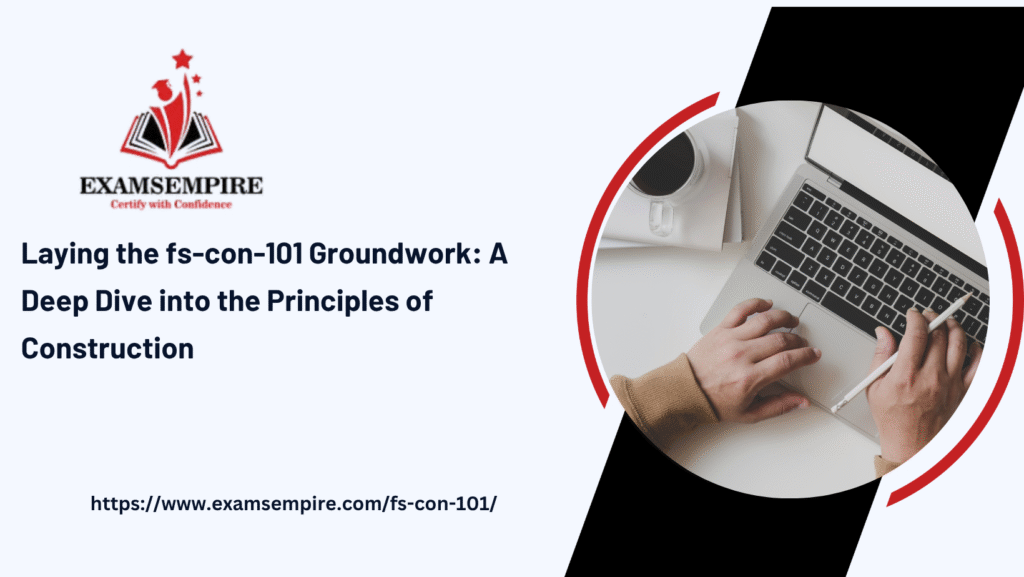Construction is one of the oldest and most essential industries in human history. From ancient stone structures to modern skyscrapers, the ability to design and build safe, durable, and efficient structures has always defined the progress of civilization. FS-Con-101, or Foundations of Construction, provides students and professionals with a strong understanding of how structures are planned, designed, and executed. It focuses on the core principles that ensure safety, sustainability, and structural integrity in every project.
Understanding the Foundations of Construction
The foundation of any structure—both literally and academically—is where everything begins. In FS-Con-101, learners start by exploring the science behind foundations, including soil testing, load distribution, and the relationship between a structure’s weight and the strength of the ground below.
Key topics include:
- Types of foundations: shallow, deep, pile, and mat foundations
- Soil mechanics: understanding soil bearing capacity and settlement behavior
- Load transfer: ensuring that the structure’s weight is properly distributed to avoid cracks or collapse
A strong foundation doesn’t only mean concrete and steel—it also means careful planning, testing, and ensuring that the structure can withstand both natural and human forces.

The Role of Design and Blueprint Planning
Every great building begins with an idea, but ideas need design to become reality. FS-Con-101 introduces learners to architectural blueprints, structural diagrams, and CAD (Computer-Aided Design) tools used in modern construction.
Students learn to interpret plans that show dimensions, materials, and reinforcement details. The design stage also includes collaboration between architects, civil engineers, and construction managers to ensure that every line on the drawing aligns with real-world possibilities.
Important aspects taught include:
- Reading construction drawings and specifications
- Understanding scale, dimension, and proportion
- Integrating design with environmental and safety standards
Blueprints serve as the communication link between imagination and implementation.
Material Science: The Building Blocks of Construction
Another major section of FS-Con-101 focuses on construction materials—their properties, advantages, and limitations. Different materials serve different structural purposes, and understanding them is vital to achieving both safety and efficiency.
Some of the most important materials include:
- Concrete: Its compressive strength and reinforcement with steel bars make it the backbone of modern construction
- Steel: Offers tensile strength and flexibility, often used for skyscrapers and bridges
- Wood: Still widely used in residential construction due to its sustainability and insulation properties
- Glass and composites: Used for modern aesthetics, energy efficiency, and lightweight design
Material science in FS-Con-101 also explores innovative construction materials, such as self-healing concrete, recycled aggregates, and green alternatives that reduce environmental impact.
For moroe information visit us
https://www.examsempire.com/fs-con-101
Safety and Risk Management in Construction
Construction sites can be dangerous places without proper safety standards. One of the core values of FS-Con-101 is to emphasize occupational safety and health protocols. Students learn how to identify potential hazards, use safety equipment, and follow international standards such as OSHA (Occupational Safety and Health Administration) guidelines.
Key focus areas include:
- Personal Protective Equipment (PPE): Helmets, gloves, boots, and visibility gear
- Site safety management: Implementing checklists and safety training sessions
- Emergency response planning: Dealing with accidents, fires, or structural failures
- Legal compliance: Understanding local and international construction safety laws
Safety isn’t optional—it’s an ethical and legal responsibility in construction management.
Project Management and Cost Control
FS-Con-101 introduces the basics of construction project management, ensuring that students understand how large projects move from design to completion. Managing construction means handling not only technical aspects but also people, money, and time.
Some crucial elements covered include:
- Scheduling tools such as Gantt charts and MS Project
- Resource allocation to ensure efficient use of materials and labor
- Budgeting and cost estimation, which help avoid overruns
- Quality control and inspection protocols
Effective management ensures that projects are delivered on time, within budget, and up to standard.
Sustainability and Green Construction
In the modern world, construction is not only about building strong structures—it’s about building responsibly. FS-Con-101 gives learners an understanding of sustainable construction practices that minimize environmental damage and optimize resource use.
Some of the sustainable topics include:
- Green building certifications such as LEED and BREEAM
- Energy-efficient designs that reduce operational costs
- Use of renewable materials such as bamboo and recycled concrete
- Waste management and water conservation on construction sites
Sustainability is no longer a choice—it’s a necessity for the future of the planet and the construction industry.
Technology in Modern Construction
The construction industry is rapidly evolving through digital transformation. FS-Con-101 introduces students to technologies shaping the future of construction:
- Building Information Modeling (BIM): A 3D modeling tool that integrates design, cost, and scheduling data
- Drones and AI: Used for site inspection, surveying, and progress tracking
- 3D printing: Revolutionizing construction by allowing entire structures to be printed layer by layer
- Smart materials: Responsive to temperature, pressure, and environmental changes
These technologies reduce human error, increase efficiency, and open new possibilities for architectural creativity.
Case Studies and Real-World Applications
To connect theory with practice, FS-Con-101 includes case studies of iconic structures and construction challenges from around the world such as the Burj Khalifa, Hoover Dam, and Golden Gate Bridge. These examples demonstrate how engineering, design, and management come together to solve complex problems and create architectural marvels.
Learners analyze:
- The design philosophy behind each structure
- How engineers overcame environmental or technical obstacles
- What lessons can be applied to future projects
FS-Con-101 is more than an introduction—it’s the foundation upon which future engineers, architects, and project managers build their expertise. It teaches that construction is both an art and a science—a field that demands precision, innovation, and responsibility. Whether it’s designing a small house or constructing a massive bridge, the principles learned in ensure that every project stands strong, safe, and sustainable.
As the world continues to grow and urbanize, the need for well-trained construction professionals has never been greater. Through FS-Con-101 pdf dumps learners gain the knowledge and confidence to contribute to the world’s infrastructure—literally building the future, one structure at a time.

